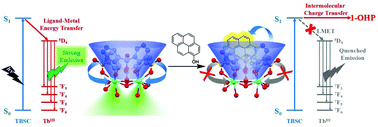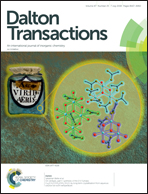Sensitive and selective urinary 1-hydroxypyrene detection by dinuclear terbium-sulfonylcalixarene complex†
Abstract
A new sulfonylcalix[4]arene-based dinuclear terbium molecular container (1) was conveniently synthesized and utilized as a fluorescence probe for the detection of a well-known biomarker 1-hydroxypyrene (1-OHP), which is used for the evaluation of polycyclic aromatic hydrocarbons (PAHs). The sulfonylcalix[4]arene ligand could not only serve as an efficient antenna ligand to promote the ligand-to-metal energy transfer but also provide a suitable cavity to accommodate 1-OHP. Promising fluorescence quenching effects were well established during the titration of the compound 1 with 1-OHP, and these effects were due to the enhancement in the host–guest intermolecular charge transfer and the decrease in the ligand-to-metal energy transfer after the formation of the stable host–guest complex. The fluorescence sensing mechanism was clearly understood through the titration experiments, and the data could be fit with the Benesi–Hildebrand and Stern–Volmer models. The TbIII-TBSC-based luminescent sensor exhibited quick response, high sensitivity, and specific selectivity to 1-OHP, even in the presence of other constituents in urine, thus providing a new sensing platform for the clinical diagnosis of human exposure to PAHs.



 Please wait while we load your content...
Please wait while we load your content...